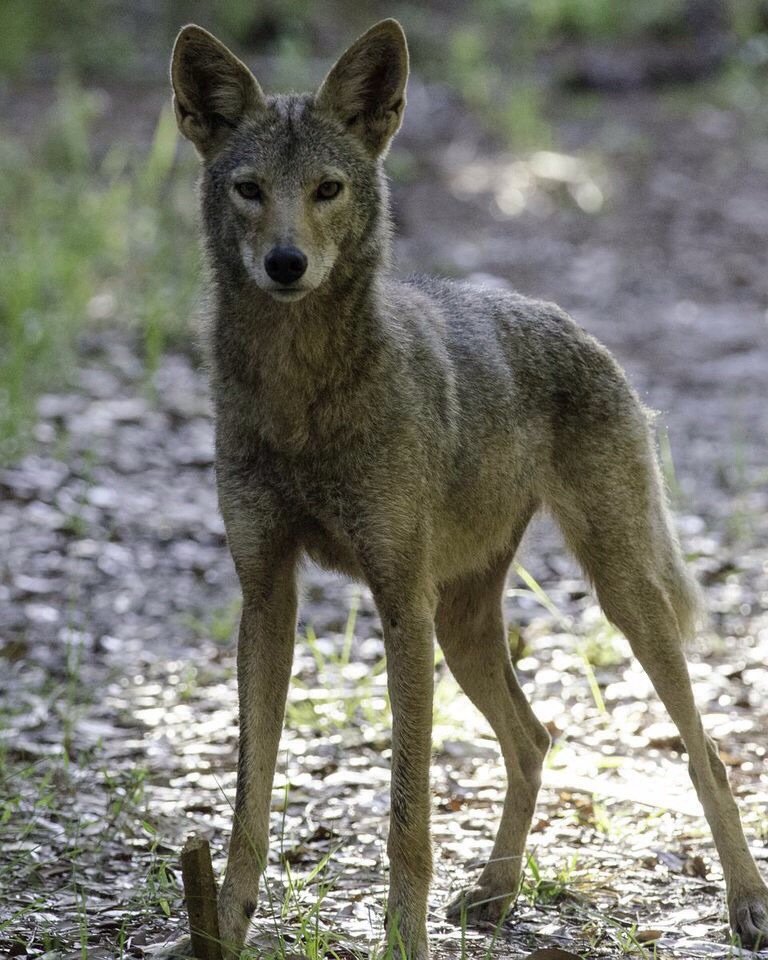Coyotes can be a nuisance to pet and livestock owners as well as vegetable farmers. They are true scavengers and will eat just about anything – sheep, calves, poultry, deer, watermelons, snakes, foxes, cats, rabbits, grass, carrion, pet food…
Although they are mainly active at night, coyotes can be seen during daylight hours close to sunrise and sunset.

Photo by J. Gamble
Coyotes are brownish gray in color with light gray or cream colored belly. They have erect pointed ears with a slender muzzle and bushy tail. They weigh between 20-45 pounds and are found in deserts, swamps, tundra, grasslands, brush, forests and even in the suburbs. Coyotes become bolder when living in urban areas and can be a threat to pets. Small dogs and pet cats are easy prey. Garbage cans are another easy food source.
So what can you do to reduce the chance of having a coyote conflict?
- First, never feed coyotes!
- Eliminate water sources near your home.
- Place bird feeders out of reach.
- Secure garbage containers.
- Feed pets indoors when possible and store pet food where coyotes cannot access it.
- Trim shrubbery near ground level to reduce hiding cover.
- Fence your yard. The fence should be at least 6 feet high with at least 6 inches buried.
- Don’t leave small children unattended outside if coyotes have been seen in the area.
- Don’t allow pets to roam free, especially at night.
- Discourage coyotes from getting too comfortable and close to humans, pets, homes, or buildings – shouting, loud noises or throwing rocks at them normally works. Coyotes generally will not challenge an adult human.
For additional information please read The Coyote: Florida’s Newest Predator from the University of Florida / IFAS.
Video of coyote in backyard of a home.
WE NEED YOUR HELP – COYOTES VS BOBCATS: WHAT ARE THEY EATING?
The University of Florida is conducting a study of coyote and bobcat diets in Florida. Your help is needed in this study. Of particular interest is the importance of popular wildlife species, including white-tailed deer, turkeys, and bobwhite quail, livestock, and pets in the diet of these predators. Diets will be determined by examining the stomach contents of coyotes and bobcats legally harvested or obtained in Florida.
We are asking for help in obtaining legally acquired coyote and bobcat carcasses, with or without pelts. We will also accept coyote and bobcat stomachs and intestines if you cannot store the whole carcass. Carcasses or stomachs and intestines should be frozen in a suitable bag or container, and include the name of contributor, animal sex, date harvested/obtained, and location harvested/obtained. We have obtained a permit from the Florida Fish and Wildlife Conservation Commission for this project, and will keep information provided by you for this project anonymous to the extent possible by law. Your assistance with this valuable study is greatly appreciated. Researchers will coordinate combining your animals with others in your area for a pickup or provide instructions for delivery in Gainesville Please contact Lauren Watine (352-846-0558; lnwatine@ufl.edu) or Bill Giuliano (352-846-0575
; docg@ufl.edu) at the University of Florida for more information.
 0
0
